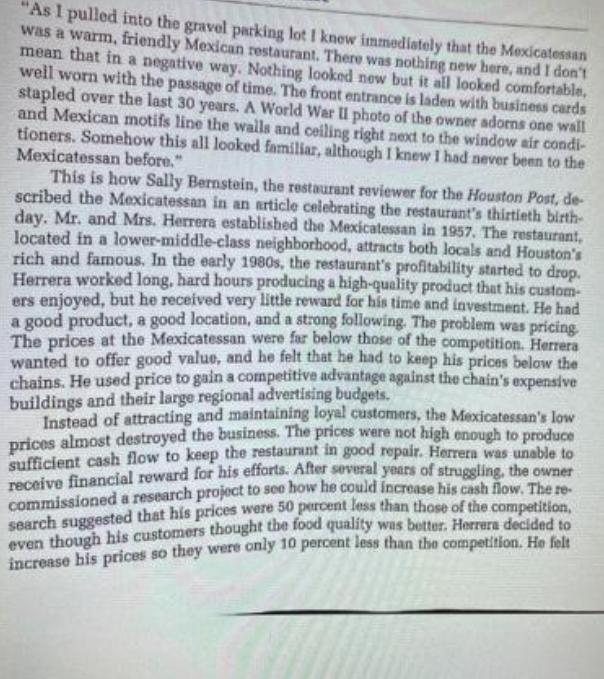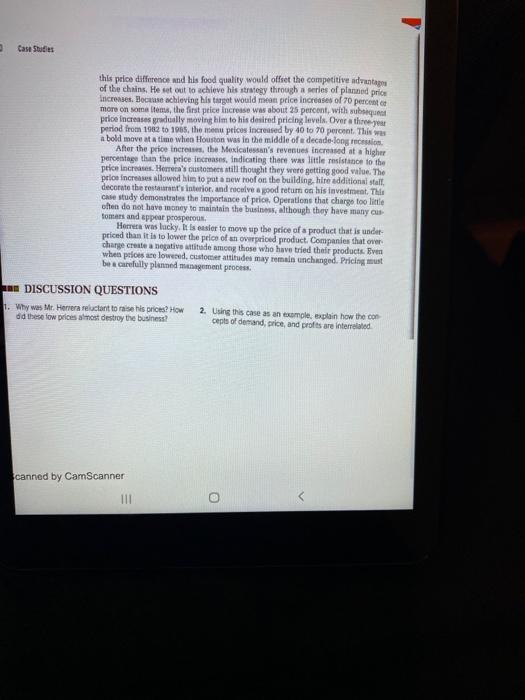Answered step by step
Verified Expert Solution
Question
1 Approved Answer
As I pulled into the gravel parking lot I know immediately that the Mexicatessan was a warm, friendly Mexican restaurant. There was nothing new
"As I pulled into the gravel parking lot I know immediately that the Mexicatessan was a warm, friendly Mexican restaurant. There was nothing new here, and I don't mean that in a negative way, Nothing looked new but it all looked comfortable, well worn with the passage of time. The front entrance is laden with business cards stapled over the last 30 years. A World War l photo of the owner adorns one wall and Mexican motifs line the walls and ceiling right next to the window air condi- tioners. Somehow this all looked familiar, although I knew I had never been to the Mexicatessan before." This is how Sally Bernstein, the restaurant reviewer for the Houston Post, de- scribed the Mexicatessan in an article celebrating the restaurant's thirtieth birth- day. Mr. and Mrs. Herrera established the Mexicatessan in 1957. The restaurant, located in a lower-middle-class neighborhood, attracts both locals and Houston's rich and famous. In the early 1980s, the restaurant's profitability started to drop. Herrera worked long, hard hours producing a high-quality product that his custom- ers enjoyed, but he received very little reward for his time and investment. He had a good product, a good location, and a strong following. The problem was pricing The prices at the Mexicatessan were far below those of the compotition. Herrera wanted to offer good value, and he felt that he had to keep his prices below the chains. He used price to gain a competitive advantage against the chain's expensive buildings and their large regional advertising budgets. Instead of attracting and maintaining loyal customers, the Mexicatessan's low prices almost destroyed the business. The prices were not high enough to produce sufficient cash flow to keep the restaurunt in good repair. Herrera was unable to receive financial reward for his efforts. After several years of struggling, the owner commissioned a research project to see how he could increase his cash flow. The re search suggested that his prices were 50 percent less than those of the competition. even though his customers thought the food quality was better. Herrera decided to increase his prices so they were only 10 percent less than the competition. He felt - Case Studies this price difference and his food quality would offiet the competitive advantages of the chains, He set out to achieve his strategy through a series of planned price increases. Bocause achleving his target would mean price increases of 70 percent e more on some itema, the first price increase was about 25 percent, with subsequeat price increases gradually moving him to his desired pricing levels. Over a threeyear period from 1982 to 1985, the menu pricos increased by 40 to 70 percent. This was a bold move at a timo when Houston was in the middle of a decade-long recesaion. After the price increases, the Mexicatessan's revenues increased at a higher percentage than the price increases, indicating there was little resistance to the price increases. Herrera's customers atill thought they were getting good value. The prios increases allowed him to puta new roof on the building, hire additional stall, decorate the restaarant's interior. and recelve a good retum on his investment. This Case study demonstrates the importance of price. Operations that charge too little often do not have money to maintain the business, although they have many cus tomars and appear prosperous. Herrera was lucky. It is easier to move up the price af a product that is undet- priced than it is to lower the peice of an overpriced product. Companies that over charge create a negative attitude among those who have tried their products. Even when prices are lowered, customer attitudes may remain unchanged. Pricing must be a carefully planned management process. n DISCUSSION QUESTIONS 1. Why was Mr. Herrera reluctant to raise his prices? How did these low prices almost destroy the business? 2. Using this case as an example, eplain how the con cepts of demand, price, and profits are interrelated canned by CamScanner II
Step by Step Solution
★★★★★
3.50 Rating (153 Votes )
There are 3 Steps involved in it
Step: 1

Get Instant Access to Expert-Tailored Solutions
See step-by-step solutions with expert insights and AI powered tools for academic success
Step: 2

Step: 3

Ace Your Homework with AI
Get the answers you need in no time with our AI-driven, step-by-step assistance
Get Started




